There have been many recent developments in the Russian RF/microwave signal generation and test & measurement industry spurred by investments from the government. In keeping with thismonth’s ‘Microwaves International’ theme, Alexander Chenakin examines some of these recent developments in the Russian market. He highlights various new technology developments and introduces some of the leading Russian companies involved in the industry.
Russia has traditionally been a large center for microwave activities.1,2 This can be traced back to 1894 when Alexander Popov built a device, called the “coherer,” that detected electromagnetic waves. Essentially, Popov’s device proved that radio communication was feasible by receiving radio waves. Since those days, Russian engineers and scientists have made major contributions to the microwave industry as recently recognized by the 2000 Nobel Prize in physics received by Zhores Alferov “for developing semiconductor heterostructures used in high-speed and opto-electronics.” More recently Andre Geim and Konstantin Novoselov (graduated from Moscow Institute of Physics and Technology and then worked at the University of Manchester) received the 2010 Nobel Prize in physics “for groundbreaking experiments regarding the two-dimensional material graphene.”
Signal generation is a key area that traditionally has attracted engineering talents. Microwave oscillators started with vacuum tubes in the 1940s and ruled the field for more than three decades.3 Reflex klystrons were a common way to generate low to moderate power levels in those days. A typical klystron capable of generating tens of milliwatts of microwave power with its DC supply used to be the size of some test equipment today. Nevertheless, it provided a relatively clean signal due to the inherent high-Q cavity utilized. Higher output power levels were achieved with magnetrons using the interaction of a stream of electrons with magnetic field. Solid-state devices started playing a role in signal generation around 1970. Gunn and IMPATT diodes were early devices that were widely used to construct microwave oscillators up to 100 GHz. A Gunn oscillator utilizes a negative resistance effect created in a solid-state diode structure when a DC bias is applied. Gunn oscillators have the advantage of lower phase noise compared to IMPATT oscillators. On the other hand, IMPATT diode oscillators exhibit a higher output power and higher efficiency compared to the Gunn. Further improvements were associated with a progress in transistor devices. The extension of the bipolar transistors to microwave frequencies and the development of GaAs FET devices in the 1970s have made compact, cost-effective and low-noise sources for use in the microwave and millimeter-wave frequency ranges possible.
The integration trend continued absorbing discrete devices into more complex and sophisticated solutions. Eventually, frequency synthesizer technologies gained in popularity. A frequency synthesizer is essentially a device that translates one (or more) input reference frequency (typically created with a crystal oscillator) to a number of output frequencies with desired characteristics. Today, the frequency synthesizer is a key component of virtually any test and measurement, communication and monitoring system. It generates a stimulus signal and is used as a local oscillator (LO) source in a variety of up- and down-conversion schemes.
Synthesizer designs utilize various techniques and are almost as diverse as the number of their applications.4,5 Although all synthesizers exhibit significant differences as a result of specific applications, they share basic fundamental design objectives. The ideal synthesizer should be broadband with fine frequency resolution that allows addressing a larger number of potential applications. Aside from frequency coverage and resolution, phase noise and spurs are critical parameters that impose the ultimate limit in the system’s ability to resolve signals of small amplitude. Another key parameter of the synthesizer that impacts overall system performance is frequency switching speed. The time spent by the synthesizer transitioning between frequencies becomes increasingly valuable since it cannot be used for data processing. Modern synthesizers tend to be faster due to the ongoing increase of the data rates of RF/microwave systems. Another challenge is cost reduction. These requirements — wide frequency coverage, small step size, fast switching speed, adequate spectral purity and low cost — are the key drivers in the development of modern frequency synthesizers.6
The Russian government recently issued several programs for research, development and innovation in science, education and technologies. Not surprisingly, there are many new developments in the RF/microwave frequency generation area.7-17 This article provides an overview of microwave oscillator and frequency synthesizer developments in Russia. It starts with crystal oscillators traditionally used as references and then progresses to chip-level and connectorized module developments. The review concludes with some more sophisticated instrument-level solutions.
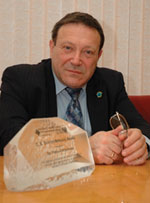
Figure 1 In 2001, Dr. Vorokhovsky received an IEEE C. B. Sawyer Memorial Award.
Crystal Oscillators
Crystal oscillators have been the industry’s workhorse for the embeddable, precise timing base used in frequency synthesizers. Morion Inc. (www.morion.com.ru) is a leading Russian supplier of quartz frequency control products such as crystal oscillators, filters and crystals themselves. They originated from a Siemens & Halske telegraph workshop established around 1855 and started the production of quartz devices in the early 1930s. Since 1971, the company has been named Morion (which is a name of the natural dark colored quartz) and is a dedicated quartz devices manufacturer. With over 75 years of experience, Morion has become a premier producer of high-end quartz products. The company is located in Saint Petersburg employing about 500 people. It is currently lead by Dr. Yakov Vorokhovsky who received a prestigious IEEE award in the quartz industry — C. B. Sawyer Memorial Award — “for outstanding entrepreneurship in leading Morion Inc. to become a world class company” (see Figure 1). Under his leadership, Morion became not only the main quartz manufacturer in Russia (over 70 percent of the market of precision devices) but also a well-known name worldwide.
Morion supports and continuously improves quality control based on Russian space and military standards as well as international standards. Since 1999, Morion has been ISO9001 certified. An advantage is that Morion controls the entire production process from a quartz blank to finished quartz oscillators at one facility. This is one key advantage that has enabled Morion to become a reliable supplier for many programs such as COSPAS/SARSAT international space search and rescue system, spacecraft “Buran,” international space station “Alfa,” international space project “Sea Launch,” NASA’s project “Mars Odyssey 2001” and others.
One of Morion’s core competencies is in the field of oven-controlled crystal oscillators (OCXO). Morion’s oscillators are certified for use in the Russian Federal Space Agency programs. For designers of frequency synthesizers, Morion has recently developed a new family of low phase noise OCXOs (MV317 and MV318) offering a noise floor down to –178 dBc/Hz and excellent aging characteristics (see Table 1). These parameters are achieved using in-house proprietary technologies for the design and production of precision blanks in combination with advanced filtering methods incorporated into the OCXO design. In contrast, the MV200 and MV220 models (see Table 2) bring temperature stability of ±2×10-10 between -40° and +85°C at a 10 MHz output. These oscillators are being used in various time keeping applications. With more than 15 percent of revenues invested annually into R&D, Morion continuously stays on top of precision crystal oscillator developments.
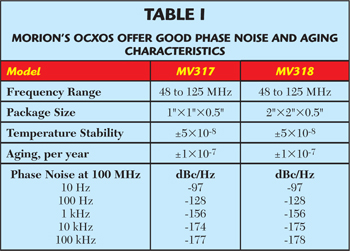
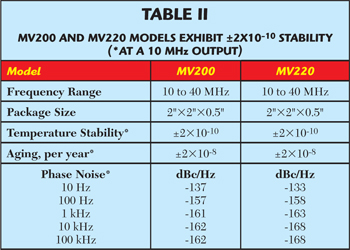
Magic Xtal Ltd. (www.magicxtal.com) was founded in 2001 as a research and production enterprise entirely dedicated to development of advanced oven controlled crystal oscillators for both domestic and international markets. The company currently employs about 80 people and is located in Omsk, a large industrial center in western Siberia. Magic Xtaldevelops and manufactures OCXOs utilizing the unique internally heated resonator (IHR) technology. The IHR design incorporates the whole oven-controlled system integrated with the crystal plate inside a miniature TO-8 vacuum holder. This ensures extremely low power consumption, very small size and short warm-up time. Permanent improvements of the IHR design have yielded a family of OCXOs exhibiting high performance characteristics. Table 3 shows the MXO37/8 and MXO37/14 models’ performance featuring the DIP8 and DIP14 compatible sizes with less than 150 mW power consumption and 15 to 45 seconds warm-up time. Despite the small sizes and low power consumption, these OCXOs have ±5 ppb frequency stability (between –40° and +85°C), less than 0.2 ppb/day aging and a phase noise floor of –173 dBc/Hz.
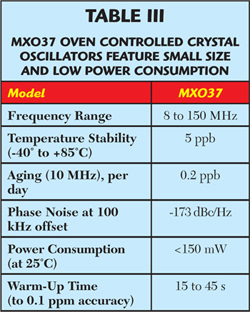

Besides the miniature low-power OCXOs, the IHR technology is successfully employed in new double-oven oscillators. The MXODR model provides excellent temperature and long-term frequency stability of a double-oven design in a compact 20 × 20 × 13 mm package (see Table 4). The MXODR oscillators are available at operating frequencies between 8 and 100 MHz and can be used as a Rubidium reference replacement.
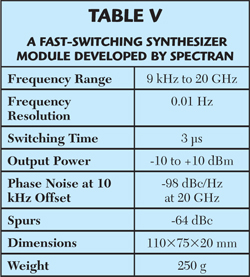
System-on-a-Chip
Frequency synthesizers come in a variety of forms ranging from tiny chips and moderate-size modules to bench-top signal generator instruments. The R&D Center ELVEES (www.elvees.ru) is situated in Zelenograd, Moscow region and focuses on system-on-a-chip (SoC) technology. A good example is the 1508PL8T direct digital synthesizer (DDS) featuring two 1 GSPS 10-bit DACs. This IC allows generating digitally programmable sinusoidal waveforms up to 400 MHz with fast frequency hopping and a fine tuning resolution of 48 bits. The frequency tuning control words are loaded into the device via a serial or parallel interface. A high-speed 16-bit parallel interface enables high data rates for advanced modulation schemes and fast reprogramming. The two available channels can operate either independently or synchronously providing quadrature output signals for IQ modulators. A unique feature of the 1508PL8T is built-in correction of phase, amplitude and DC offset. Being properly applied, this correction allows suppressing the LO leakage and unwanted sideband in IQ modulators. It also supports a user defined linear sweep, linear FM, up/down ramp at different rates, optional phase reset and mute. The IC is specified to operate between –60° and +85°C. Applications include agile frequency synthesizers, programmable clock generators, FM chirp sources for radars and test and measurement equipment.
Modules
Synthesizer modules are developed by many Russian companies. Spectran (www.spectran.org) was founded in 2004 in Saratov. The company collaborates with the Central Research Institute of Measurement Equipment developing various frequency synthesizer products. One of the new designs is a low-cost 20 GHz synthesizer module presented in Table 5. This is a phase-lock-loop (PLL) design that integrates a DDS for fine frequency resolution. The module provides 9 kHz to 20 GHz frequency coverage with fast switching speed and a resolution of 0.01 Hz. Phase noise performance is shown in Figure 2. The spur level is managed by simultaneously changing the DDS clock frequency and PLL division ratio. Optimal DDS clock frequencies and division ratios are stored in an internal memory and then fetched by an FPGA that controls synthesizer components. The synthesizer is programmed via a parallel interface; USB, SPI and LAN options are available as well. The design is implemented in a compact metal housing that is 110 × 75 × 20 mm in size.
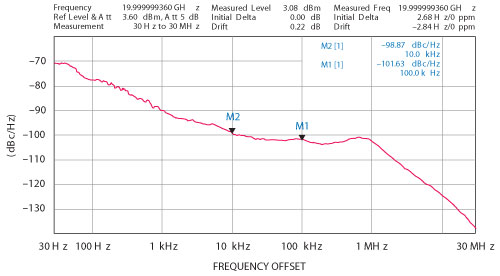
Figure 2 Spectran's synthesizer phase noise performance at 20 GHz.

The research and production company Micran (www.micran.ru) was founded in 1991 in Tomsk (western Siberia). Today Micran is a large enterprise employing more than 1100 people that develop and manufacture complex RF/microwave equipment for the test and measurement and related markets. Micran’s products include vector and scalar network analyzers, spectrum analyzers, noise figure analyzers and signal sources up to 60 GHz. New developments and research activities are carried out in close cooperation with Tomsk State University of Control Systems and Radioelectronics. Recent developments include a 3 to 8 GHz YIG-based synthesizer for embedded applications (see Table 6). The synthesizer utilizes a high-frequency sampler that provides frequency conversion within a PLL feedback to ensure low phase noise and low spurious characteristics. A DDS is used as a PLL reference for small frequency steps. The synthesizer provides less than 1 Hz frequency resolution, phase noise of –130 dBc/Hz at 10 kHz from the 4 GHz carrier and fast frequency settling of 500 µs. These high performance characteristics are in a compact 250 × 112 × 45 mm module that includes multiple interfaces. The module also incorporates a built-in YIG preselector driver that can be conveniently used in spectrum analyzer instruments.
Another interesting Micran design is its compact, dual-output microwave synthesizer, shown in Figure 3. It consists of two independent channels that utilize ceramic coaxial resonator oscillators (CRO) running at 1 and 3.5 GHz, respectively. Both CROs are locked to an external reference supplied via an MCX connector. A frequency offset PLL architecture is utilized in both synthesizers to minimize noise. The phase noise at 100 kHz offset is about –140 and –128 dBc/Hz at 1 and 3.5 GHz, respectively. This module can be used in various double-conversion receiver schemes where two independent low-noise LO signals are required.
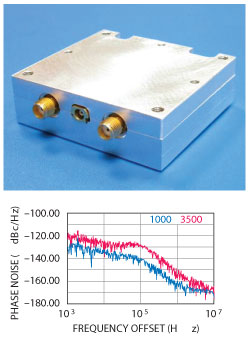
Figure 3 Micran's low noise CRO synthesizer provides two signal outputs.
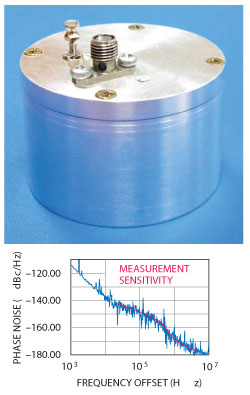
Figure 4 A 4 GHz low noise DRO exhibits about –140 dBc/Hz at 10 kHz offset.
Micran also develops various oscillator products based on LC, quartz, SAW, YIG and sapphire resonators.17 They manufacture a 4 GHz ultra low-noise dielectric resonator oscillator (DRO) shown in Figure 4. The design utilizes a high-Q dielectric resonator (Q < 8000) as well as a silicon bipolar transistor with low flicker noise. The resonator is placed into a relatively large metal chamber (the distance from the chamber walls is 3 to 5 times greater than the dielectric puck radius). This allows achieving remarkable phase noise performance that is close to –140 dBc/Hz at 10 kHz offset from 4 GHz carrier.

Figure 5 A 24 GHz fast-switching synthesizer (a) and 1.4 to 2.8 GHz synthesizer (b).
Radiocomp LLC (www.radiocomp.ru) was started in 1995 in collaboration with Moscow Technical University of Communication and Informatics (MTUCI). The company is located in Moscow and is led by Dr. Kochemasov, a well-known Russian expert in the frequency synthesis field. The company’s staff includes 25 full-time employees and also collaborates with R&D teams from MTUCI and Moscow Power Engineering Institute (MPEI). An interesting recent development is the company’s 6 GHz frequency synthesizer, SLFM-RC-2500, that is capable of generating precise linear FM signals with up to 600 MHz frequency deviation. The modulation is realized by utilizing a two-channel DDS and IQ-modulator. The synthesizer is available as a compact module measuring 112 × 57 × 21 mm in dimensions.
Special Technological Center(STC) in Saint Petersburg (www.stc-spb.ru) was founded in 2001 as a design, development and manufacturing company specializing in test and measurement equipment for radio-monitoring and frequency management. The company’s product lines include multi-channel measuring receivers, RF/microwave direction finders, various types of antennas and other monitoring systems from 10 kHz to 40 GHz. The company uses frequency synthesizers widely in their internal developments and also offers them as stand-alone modules such as presented in Figure 5. The 24 GHz fast-switching synthesizer provides a 200 MHz step size with –105 dBc/Hz phase noise and incorporates an integer-N PLL with high phase detector comparison frequency for fast switching (see Figure 5a). A 1.4 to 2.8 GHz synthesizer incorporates a DDS for fine resolution (see Figure 5b).
Instruments
Broadband operation, fine frequency resolution, low spurious and low phase noise are the key specifications for test and measurement signal generator instruments. As a dedicated test and measurement equipment manufacturer, ELVIRA Production Co. Ltd. (www.elvira.ru) offers spectrum analyzers and synthesized signal generators up to 40 GHz. Elvira is a private company founded in 1993 and is located in Zheleznodorozhny, Moscow region. Since its founding, the company has committed to designing the most advanced instruments for communications, scientific and aerospace applications. A good example is SK4-BELAN, a 40 GHz spectrum analyzer (shown in Figure 6) that displays the highest level of performance offered by the Russian industry today. The model offers analysis bandwidths of 30 MHz and optionally 160 MHz, phase noise of –125 dBc/Hz at 10 kHz offset from 10 GHz carrier, TOI of +20 dBm and –150 dBm/Hz DANL across the entire frequency range. An optional preamplifier further improves DANL down to -165 dBm/Hz at 40 GHz.
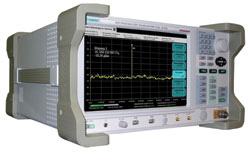
Figure 6 SK4-BELAN is a 40 GHz spectrum analyzer.
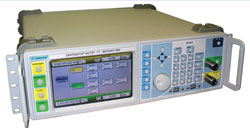
Figure 7 BELSYNTH signal generator provides two independent signal outputs from 10 MHz to 20 GHz.
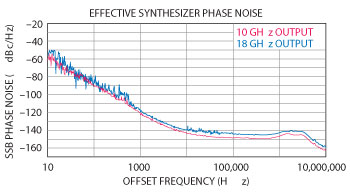
Figure 8 Elvira utilizes a sapphire loaded cavity oscillator for further phase noise improvements.
ELVIRA also has two lines of signal generator instruments. The BELSYNTH bench-top generator (see Figure 7) utilizes two Phase Matrix QuickSyn synthesizer modules featuring excellent spectral purity and fast tuning speeds inherent to the QuickSyn technology. The BELSYNTH also adds low-frequency extension, step attenuator, high output power of +28 dBm, additional harmonic rejection, built-in modulation sources and other important functions. The two channels can be synchronized or tuned independently, essentially offering two independent generators in one box.
Future developments include a new synthesizer, SAPSYNTH, which is only available as a prototype at this point. This can be considered as a new breed of frequency synthesizers in terms of spectrum quality. Rather than being built around a traditional 100 MHz OCXO, it uses an ultra-low noise sapphire loaded cavity oscillator. This synthesizer is intended to provide a significant improvement in terms of phase noise performance. The prototypes demonstrate phase noise of –140 dBc/Hz at 10 kHz offset from 18 GHz carrier (see Figure 8) with a potential for further improvements. This new synthesizer core can also be used in novel phase noise measurement systems to boost the raw sensitivity of phase noise measurements.
Founded in 2004, Advantex LLC (www.advantexrf.com) is located in Moscow and develops various RF/microwave modules such as frequency synthesizers, up/downconverters, modulators, demodulators and transceivers for digital communications, radar and other applications. Since 2010, Advantex also develops test and measurement instruments such as the SG8 bench-top signal generator shown in Figure 9. The generator provides 10 MHz to 8 GHz frequency coverage with 0.001 Hz resolution, –65 dBc spurs and output power up to +28 dBm. This high output level enables various measurements without additional power amplifiers. Phase noise performance is depicted in Figure 10. A distinctive advantage of this instrument is its attractive price-to-performance ratio in its instrument class.
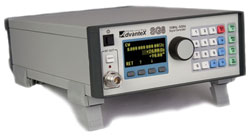
Figure 9 Advantex' SG8 signal generator.
Planar LLC (www.planar.chel.ru) is a privately owned company based in Chelyabinsk, a big industrial city located on the east side of the Ural Mountain range in central Russia. The company was founded in 1992 and currently manufactures various products for telecommunications and the test and measurement market. Some of Planar’s products are frequency synthesizers developed as a key part of Copper Mountain Technologies’ (www.coppermountaintech.com) line of vector network analyzers. These VNAs are designed for operation with an external computer (such as the 804/1 model shown in Figure 11). Fast-switching synthesizers are integrated to provide the required frequency coverage with minimal acquisition time. These analyzers are an excellent value solution for performing the full range of magnitude and phase measurements over the frequency range of 20 kHz to 8 GHz.

Figure 10 Phase noise perfomance of Advantex' SG8 generator.
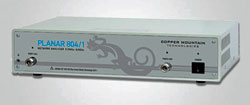
Figure 11 The 804/1 VNA is based on Planar's fast-switching synthesizers.
Acknowledgments
This article presents a brief overview of some selected developments in the area of frequency generation and synthesis that have recently occurred in Russia. Further details can be found in the references. The author would like to thank Y. Vorokhovsky, V. Kochemasov, L. Belov, S. Beltchicov, Y. Petrichkovich, V. Romashov, A. Gorevoy, A. Polyakov, S. Zaostrovnykh, A. Goloschokin, A. Anufriev, I. Abramzon, A. Pivak, Y. Matveev and many other colleagues who have provided the material for this article.
References
- R. Sorrentino and A. Vander Vorst, “Microwaves in Europe: Historical Milestones and Industry Update: Part 1,” Microwave Journal, September 2008, pp. 28-68.
- R. Sorrentino and J. Grahn, “European Microwaves,” IEEE Microwave Magazine, September-October 2012, pp. 65-79.
- A.P.S. Khanna, “Microwave Oscillators: The State of the Technology,” Microwave Journal, April 2006, pp. 22–24.
- V. Manassewitsch, Frequency Synthesizers: Theory and Design, 3rd ed., NJ, Wiley, 2005.
- A. Chenakin, Frequency Synthesizers: Concept to Product, Artech House, Norwood, MA, 2010.
- A. Chenakin, “Frequency Synthesis: Current Solutions and New Trends,” Microwave Journal, May 2007, pp. 256-266.
- A.I. Kabanov and V.V. Shakchgildian, “Recent Developments in Frequency Synthesizers in Russia,” 23rd European Microwave Conference Proceedings, September 1993, pp. 26-29.
- V.N. Kuleshov and T.I. Boldyreva, “l/f AM and PM Noise in Bipolar Transistor Amplifiers: Sources, Ways of Influence, Techniques of Reduction,” Intl. Frequency Control Symp. Proc., May 1997, pp. 446–455.
- D.P. Tsarapkin, “Low Phase Noise Sapphire Disk Dielectric Resonator Oscillator with Combined Stabilization,” International Frequency Control Symposium Proceedings, June 1994, pp. 451-458.
- D.P. Tsarapkin and N.A. Shtin, “Whispering Gallery Traveling Wave Interferometer for Low Phase Noise Applications,” International Ultrasonics, Ferroelectrics and Frequency Symposium Proceedings, August 2004, pp. 762-765.
- V.V. Romashov, L.V. Romashova and K.K. Khramov, “Research of Phase Noise of Direct Digital Synthesizers,” International Siberian Conference on Control and Communications, September 2011, pp. 168-171.
- L.A. Belov, “Stable Frequency Synthesizers,” Electronika NTB, No. 3, 2004, pp. 38-44 (in Russian).
- B.I. Shahtarin, Frequency Synthesizers, Moscow: Hot Line - Telecom, 2007 (in Russian).
- N.M. Tikhomirov, S.K. Romanov and A.V. Lenshin, FM Signals Formation in PLL Synthesizers, Moscow: Radio and Communication, 2004 (in Russian).
- S.K. Romanov, N.M. Tikhomirov and A.V. Lenshin, Pulse Phase-locked-loop Frequency Control Systems in Frequency Synthesizes and Stabilization Devices, Moscow: Radio and Communication, 2010 (in Russian).
- S. Beltchicov, “Phase Noise: Getting -120 dBc/Hz at 10 kHz Offset in the 14 GHz Frequency Range or Fighting for Decibels,” Components and Technologies, No. 6, 2009, pp. 142-147 (in Russian).
- A. Gorevoy, “Oscillator Selection for Microwave Synthesizers,” Components and Technologies, No. 6, 2012, pp. 12-17 (in Russian).
Dr. Alexander Chenakin is the vice president of signal sources at Phase Matrix, a National Instruments company, where he oversees the development of advanced signal generator products for test and measurement applications. His professional interests also include various microwave components and subsystems including low phase noise oscillators and frequency synthesizers. His professional achievements have been widely presented in trade publications and international conferences. Chenakin has also authored a book on frequency synthesizers. He is a senior IEEE member and has been an invited speaker for several IEEE-sponsored events.
